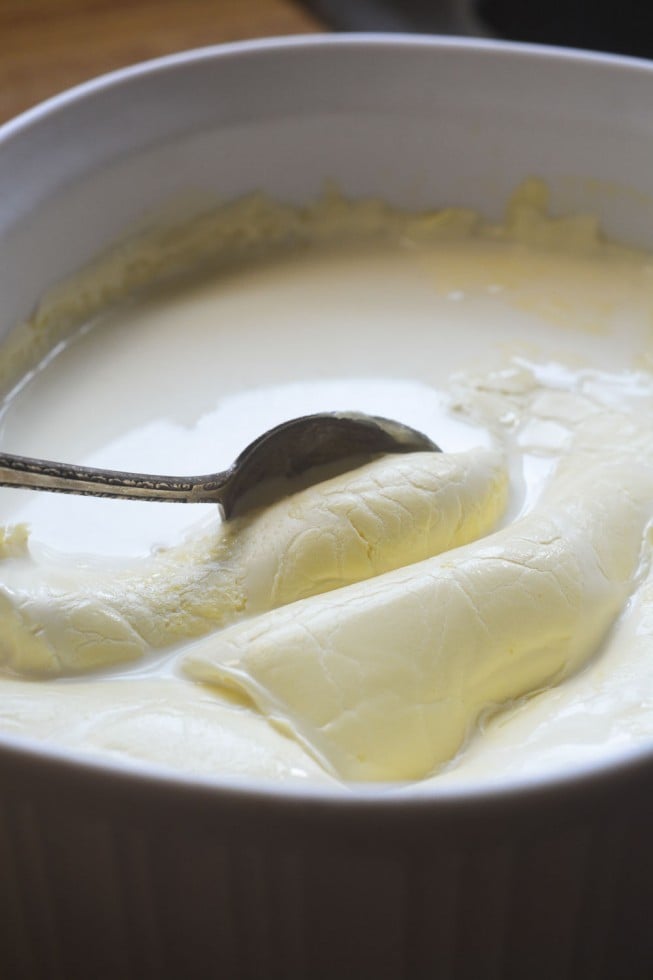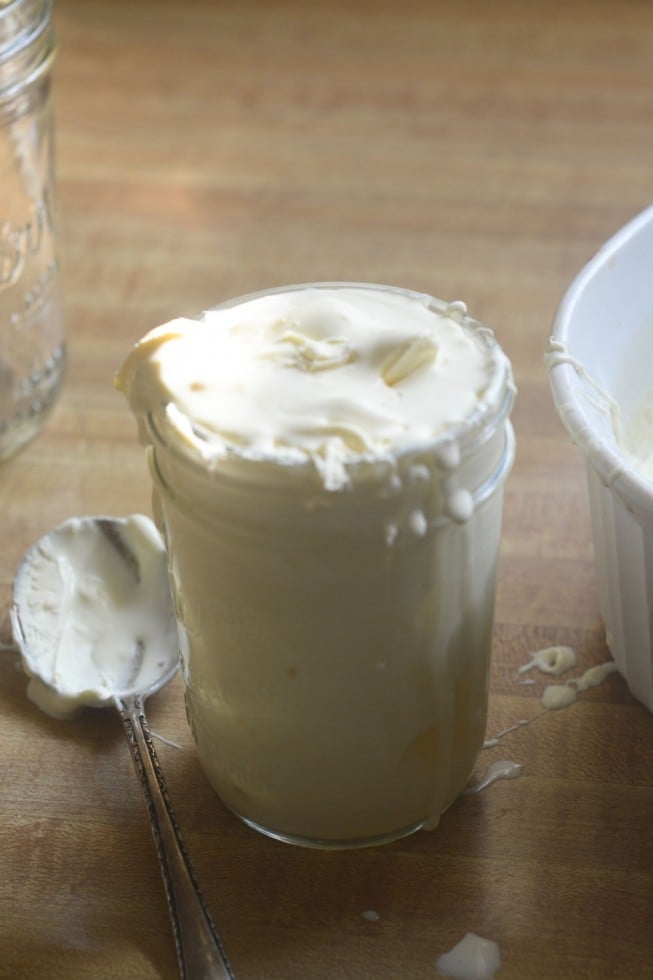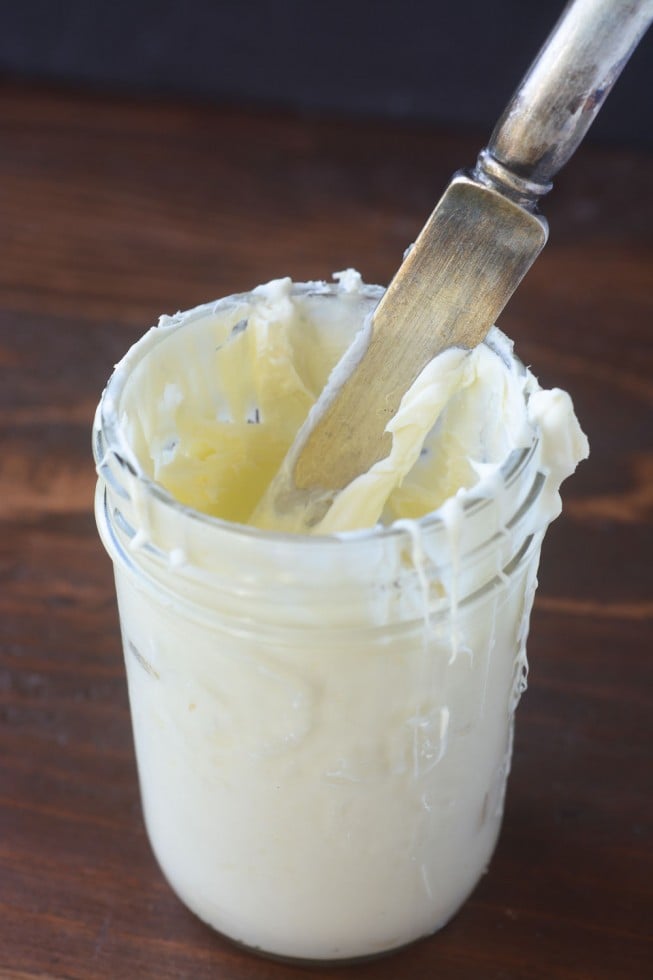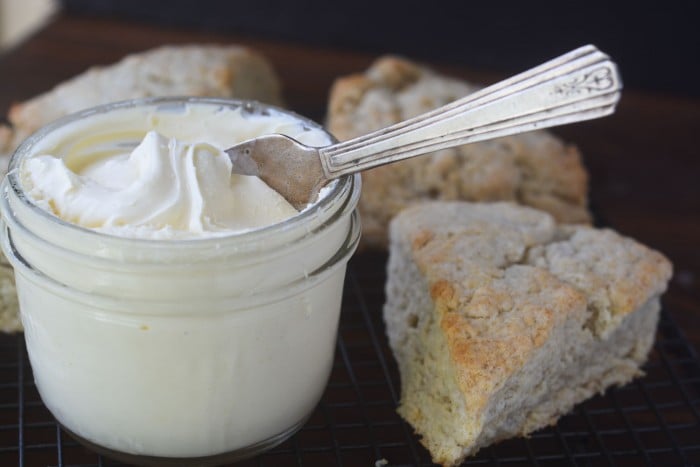“I have a British background and I have always had tea and something sweet. First time I tried this clotted cream I almost ate the entire jar by itself, it is that good!” ~Kim

If you’ve never had a classic English afternoon tea with scones and clotted cream, you’re missing out!
Last week I was treated by the historic Biltmore Hotel in downtown Los Angeles to their classic English afternoon tea. If you’ve never had a classic afternoon tea, you need to experience it. The highlight of any afternoon tea, besides the tea, is the array of tiny treats that comes with it, and I always zero right in on the scones and clotted cream. (That’s them on level two of our 3 tiered tea tray.)

What is Clotted cream?
If you’ve never had it, clotted cream is a very thick rich spreadable form of heavy cream that was first invented ages ago by some very smart British farmers. Traditionally cream heated until it thickens and develops a slightly nutty flavor. Clotted cream has a high fat content (around 55-65%) and a dense texture. It’s not like whipped cream, or cream cheese, it’s not like butter…it has a unique decadent consistency and a wonderful soft flavor. It’s quite thick and spreadable, and when you slather it on a freshly baked scone there is no better thing in the world.
The little pot of clotted cream that we got at the Biltmore had me craving more, and happily I made the most astounding discovery…you can actually make clotted cream at home in your own kitchen. No more tracking it down in specialty stores and paying big bucks for the imported stuff. My homemade clotted cream was actually way better (and a whole lot fresher) than the British stuff I usually buy.

What does clotted cream taste like?
Clotted cream has a rich, creamy taste with a slightly nutty ‘cooked’ flavor. It’s luxurious and indulgent, with a dense, velvety texture that is thicker and creamier than regular whipped cream. Clotted cream is also slightly sweet, but not as sweet as whipped cream or frosting, with a delicate flavor that pairs well with desserts, fruit, and scones. The crust on top of the clotted cream adds a slightly caramelized and nutty flavor, which many people find particularly delicious. The mouthfeel of clotted cream is a key part of its charm, and is like nothing else you’ve ever had!
what you’ll need
- heavy or whipping cream that has not been ultra-pasteurized
- This is cream that has been pasteurized, but not ultra-pasteurized. Ultra-pasteurized cream is cream that has been heated to a higher temperature than regular pasteurized cream to extend its shelf life.

How to make clotted cream
This is an amazing process, I hardly had to do anything, and I end up with a ton of the richest, silkiest clotted cream I’ve ever had.
- I used 2 pints of (non-ultra-pasteurized) heavy cream.
- I poured them into a baking dish, and left it overnight in a 180F oven (the lowest my oven will go.)
- In the morning I let it cool and then refrigerated it for the rest of the day.
- Then I scooped it into jars, which was a little sloppy at first, and put them back in the refrigerator. Any little bit of liquid gets absorbed right into the clotted cream after you put it in the jars, and by the next morning when I had it with my scones, it was absolutely to die for.

How long does clotted cream last?
Homemade clotted cream can last for up to 3-4 days when stored properly in the refrigerator. To extend its shelf life, it’s important to keep it in an airtight container and store it in the coldest part of the refrigerator, such as the back of the bottom shelf.
It’s important to note that clotted cream does not have any preservatives, so it should be consumed as soon as possible for the best flavor and texture. If you notice any changes in color, texture, or odor, discard the clotted cream immediately as it may have spoiled.

What to do with the leftover whey from making clotted cream
The leftover whey from making clotted cream can be used in a variety of ways:
- Adding it to smoothies or protein shakes for a boost of protein and nutrients.
- Using it as a substitute for milk or water in baking recipes such as bread, muffins, and pancakes.
- Using it as a marinade for meat or fish to tenderize and add flavor.
- Adding it to soups or stews for added richness and flavor.
- Using it as a liquid base for making homemade ricotta cheese or other soft cheeses.
- Feeding it to pets, as it is a good source of protein and nutrients for animals.
Note: It’s important to keep in mind that the leftover whey should be used or stored promptly to avoid spoilage. It can be stored in the refrigerator for up to a week or frozen for longer storage.

I can’t say enough good things about this project, the results far exceeded my expectations and it was absurdly easy. The only catch is that you can’t use ultra-pasteurized cream, which is cream that’s been processed for a longer shelf life. Many stores only sell ultra-pasteurized cream, so you have to search a bit for regular cream. I found mine at Whole Foods. Just read the labels… if it doesn’t say ultra-pasteurized on the label, you’re good to go.
can you make clotted cream with ultra-pasteurized cream?
Some readers in the comments below have had success with ultra-pasteurized cream. It is possible to make clotted cream from ultra-pasteurized cream, but it may be more difficult to achieve the desired texture and flavor. Ultra-pasteurization is a process that heats the cream to a higher temperature than regular pasteurization, which extends its shelf life but can also alter the proteins and enzymes in the cream. This can make it more difficult for the cream to form clots, which are necessary for making clotted cream.

What to eat with your homemade clotted cream
You will definitely want to make scones to go with your homemade clotted cream. I have lots of recipes for scones on the blog, but a simple one to start with is my Classic Cream Scones Recipe.

Tips for making clotted cream
- Make sure your cream is not ‘ultra pasteurized’, you will need to find regular pasteurized cream at a Whole Foods or other similar store. Ultra pasteurized cream has been treated in a way that prevents it from ‘clotting’.
- An oven thermometer is an essential kitchen tool, and really comes in handy for this project. If your oven is too cool or too hot your homemade clotted cream will not ‘clot’. Set your oven to 180F and then check the thermometer. You can adjust up or down as necessary.
- If your oven does not go down as low as 180F you can try one of my other methods for making clotted cream:

Homemade Clotted Cream
Video
Equipment
- a heavy casserole dish
Ingredients
- 2 pints heavy cream or whipping cream (double cream in the UK), avoid ultra-pasteurized cream for best results.
Instructions
- set your oven to 180F
- Pour the cream into the casserole dish. It should come up about 1-3 inches on the side.
- Set the dish, uncovered, in the oven and leave undisturbed for 12 hours. Be sure to leave the oven on the whole time. I do this overnight.
- Remove the dish from the oven and set to cool. Then cover and refrigerate. Note: the cream may seem thin at this point, but is going to thicken considerably overnight.
- The next morning scoop the thickened cream into a jar or jars, and cover and put back in the refrigerator. You can use the leftover cream for baking..
- Spread the clotted cream on freshly baked scones.
Nutrition























Presently on my second attempt on this recipe and quite excited to achieve some improved results. With my first attempt, my clotted cream was quite thick and had an unfortunately sour taste. If anyone as a recommendation on how to avoid the sour taste then I would be very eager to apply a recommended solution or remedy. I am using cream from Trader Joe’s which to date is the only non-ultra-pasteurized heavy cream that I can find in my area.
Hi, depending on where you live you might try yourfamilyfarmer.com or https://www.naturalbynaturedairy.com/milk-myths
The clotted cream I had in England had a slight sweet taste to it. Do you ever add sugar to it?
No, I don’t add sugar, but I think that sweetness you remember comes from the cream itself. The flavor of cream comes from the specifics of the cows and how and where they are raised, etc, so English clotted cream might be a bit sweeter due to that.
I know farmers who add black strap molasses to their hay. Milk from them is the best. I’m sure this recipe with their cream would be amazing. Probably only smaller farms do this tho.
Wow that does sound intriguing!
I want to make this. How long does the cream keep after clotting? My little jars of store bought last about a week.
Can I make a smaller batch so it doesn’t spoil before I can eat it!
It will last about a week Cindy. It’s hard to make a smaller batch because you need the volume for the process to work.
You can freeze it and then thaw it in the refrigerator before using it again. I have personally done this and it works just fine.
Omg! If this works you will be my bff!!
Mine is in the oven and I am not really worried about it turning out. I’m pretty sure it’ll be great. Just want to share that I live in a small town without a Whole Foods, Sprouts or TJ’s in sight. I was able to find Anderson Dairy heavy cream which is not ultra pasteurized at my local Albertsons. Must be the right stuff cause it expires next week where all the others on the shelf are good through October.
Making clotted cream is an adventure, for sure Danielle, let us know how you do…
I made this exactly to the recipe and it came out perfect.
4 cups of heavy cream, baked for 12 hours at 180F. I used a 8 inch round Pyrex casserole. The depth of the cream was at 2 inches, and kept a thermometer in it just in case, checked it every 3 hours to make sure temp stayed at 180F.
When it came out of the oven it looked perfect, lite golden yellow with a small amount of butter on top. I thought the recipe had failed because it seemed to only have a thin 1/4 inch thickness of almost crust and was very runny underneath. I refrigerated for 9 hours and almost 85% of it clotted up, only had less than a cup left as a runny milkish product. The cream itself was really thick, I had to pour some the leftover back into it to make it creamy/spreadable. The taste is fantastic. I will make this again.
The only hard part was finding the non ultra pasteurized heavy cream. Every normal grocery only had ultra pasteurized but I went to Whole Foods and they had some litely pasteurized, non homogenized heavy cream. WooHoo, I hit the jackpot there, however it was $12 for a half gallon.
I have tried this recipe before with normal store bought heavy cream and it fails, it won’t clot or clots very little. It has to be litely pasteurized/non homogenized heavy cream to clot up correctly.
Overall 5 star rating, the recipe is right on.
Spot on Mark ~ I couldn’t have said it better myself!
This is my first attempt at making clotted cream. Did everything according to the directions and when I took it out of the refrigerator some of it was lumpy like cold butter. Is this normal? My fridge runs pretty cold. Would that have caused the lumps? How is it supposed to look and can I fix what I have?
The lumps are ok, Jann, clotted cream is supposed to be like ‘clots’. You can stir it up, even adding a little bit of the whey, to make it smoother, but don’t stress, as long as it tastes amazing!
Just came back from England and craving some of this. I used to eat this often growing up in the tropics. We just called it milk cream! So yummy. Your recipe is a lot easier to make and will do that as soon as I run to the store for some heavy cream. Thanks.
Thank you for posting this amazing recipe. Can you tell me what the shelflife is for this? I can’t wait to make this one.
Clotted cream doesn’t last super long, Corina, mine tends to last about 3 weeks.
Your recipe sounds delicious. How much clotted cream does your recipe make and how long will it keep in the refrigerator?